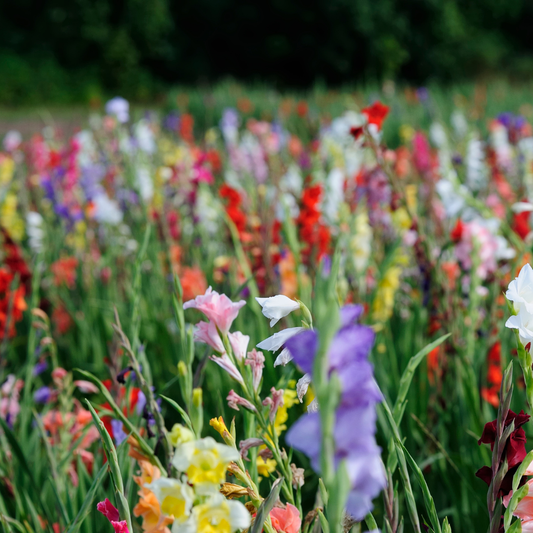
When to Plant Easter Flowers?
Share
When to plant Easter flowers?
If the word "Easter flowers" immediately makes you think of a colorful bouquet on the table at Easter, you're in the right place. Easter flowers—often daffodils, hyacinths, grape hyacinths, or tulips—bring a cheerful touch to your garden or flower box in the spring. But to get those flowers to bloom in time, it's wise to know when and how best to plant them.
What are Easter flowers anyway?
Easter flowers is a collective name for flowers typically associated with Easter. They usually bloom in March and April and are true spring classics like daffodils, tulips, crocuses, and hyacinths. They are often planted as bulbs and sometimes sold as potted plants at the end of winter.
Want to know more about the ideal time to plant tulips? Then check out our blog post about when to plant tulips .
When to plant Easter flowers in open ground?
Most Easter flowers are planted in the fall, ideally between mid-September and late November. By planting the bulbs before the first frost, you give them the chance to establish themselves and develop strong roots.
A partly cloudy or rainy day is ideal. This prevents the soil from drying out immediately after planting, and you avoid sunny days where the bulbs could dry out before they root. For additional tips on flower bulbs in pots or gardens, we're happy to help you with our blog post about when to plant flower bulbs .
How to plant Easter flowers outdoors?
Choose a sunny to partially shaded spot in your garden with well-draining soil. Dig a hole about twice as deep as the bulb's height, place the bulb pointed upward, and cover with soil. Adding a little compost will make it even better.
After planting, you generally don't need to water unless it remains dry for a prolonged period. Autumn rain will usually be sufficient. If you have poor or dense soil, you can add some perlite to improve drainage.
When to plant Easter flowers in a greenhouse?
Want earlier blooms or don't have a garden? Then a conservatory or greenhouse is the perfect spot. Here, you can plant your Easter flowers a little later—until December—because they're somewhat sheltered from frost. Just make sure there's sufficient light.
In the greenhouse, it's best to use potting soil specifically formulated for flower bulbs, or add amendments like vermiculite to regulate moisture. Water carefully and ensure excess moisture drains easily. Let the bulbs rest until they begin to grow around February.
Easter flowers in a pot or flower box
No garden? No problem! Easter flowers are also ideal for your patio or balcony. Use a large pot with holes in the bottom, fill with suitable potting soil (possibly with hydroponic pebbles at the bottom), and plant them as you would in the ground.
An advantage of pots is that you can bring them inside during a hard frost. After planting, keep the pot in a cool, frost-free place for a while if you want to control the flowering period. For more information, be sure to check out our blog post about when to plant flower bulbs in flower boxes .
What types of Easter flowers are there?
Typical species include:
- Daffodils: they bloom bright yellow or white and are usually the first flowers you see in bloom
- Hyacinths: spread a wonderful perfume
- Tulips: extremely popular in all colours
- Blue grape hyacinths: small balls with bright blue flowers
These bulbs all need a period of cold to bloom, hence the importance of planting them in the fall. For other flowers that emerge in spring, you can also read our blog post about when to plant crocuses .
Aftercare and tips for Easter flowers
Have they finished blooming? Then leave the foliage for a while. The longer the leaves can continue growing after flowering, the more energy they can store for next year. Only prune when the leaves have turned completely yellow.
After flowering, give it some extra feed with bulb fertilizer and ensure the area doesn't remain permanently wet; this helps prevent rot. Want more cheerful spring bloomers? Then don't forget to add daffodils or hyacinths to your garden or flowerpot.
A bonus idea: combine Easter flowers
Want to create a spectacular Easter border? Layer Easter flowers. Plant tulips first, then hyacinths, and finish with crocuses or grape hyacinths closer to the surface. This way, you'll have weeks of blooms and color.
Use additional tools such as a repotting mat to keep things tidy indoors, or choose a beautiful matching pot or planter from our collection.
Schedule an annual planning session
Remind yourself to plant your Easter flowers on time every September. It's a small effort with a big reward in spring. And whether you plant them in a wild garden, a balcony with a fresh calla lily , or a chic pot on the windowsill: springtime is guaranteed!
If you want to be sure your bulbs bloom at the perfect time, our flower box subscription might be just what you need. A perfectly planted flower box every season, worry-free.
Conclusion
In short: Easter flowers like tulips and daffodils are ideally planted in the fall, preferably on a cloudy or rainy day. They need that cold period to truly blossom in spring. Whether you plant them in the ground, a greenhouse, or a pot, with a little preparation you can transform your garden or patio into a cheerful Easter paradise.
And if you'd like some greenery fun in between, take a look at our easy houseplants for beginners for some instant green satisfaction indoors.


